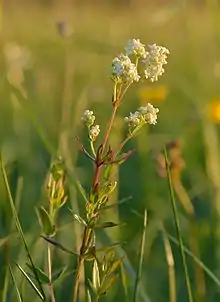Galium boreale
Galium boreale or northern bedstraw[1] is a perennial plant species of the Rubiaceae family. It is widespread over the temperate and subarctic regions of Europe, Asia and North America including most of Canada and the northern United States.[2][3][4]
| Northern bedstraw | |
|---|---|
 | |
| Scientific classification | |
| Kingdom: | Plantae |
| Clade: | Tracheophytes |
| Clade: | Angiosperms |
| Clade: | Eudicots |
| Clade: | Asterids |
| Order: | Gentianales |
| Family: | Rubiaceae |
| Genus: | Galium |
| Species: | G. boreale |
| Binomial name | |
| Galium boreale | |
Description
G. boreale is a perennial plant that dies back to the ground every winter.[5][6] Established plants spread by rhizomes, creating colonies of new plants around the original one.[5][6][7]
The squarish unbranched stems may grow between 20 centimetres (7.9 in) and 50 centimetres (20 in) tall.[5][6] The leaves are attached directly to the stem in groups of four; spaced evenly like the spokes of a wheel.[5][6][7] Leaves are longer than they are wide and have three prominent veins.[5][6][7]
The small white flowers grow in a fairly showy panicles from the top of the stem.[5][6][7] Each individual flower has 4 pointed segments that fold back from a fused tube enclosing the stamens and pistil.[5][6] The lightly perfumed flowers have no calyx.[5][6] Seeds are formed in pairs in dark fruits that may be covered in short hairs.[5][6][7] The Latin specific epithet boreale means northern.[8]
Habitat and distribution
Galium boreale is found in sunny areas with dry to moist soil in forests, shrubs or grassland.[5][6] It is native to the sub arctic and temperate zones of the Northern Hemisphere.[9][7] It is listed as endangered in the states of Maryland and Massachusetts.[10]
Ecology
Galium boreale is confirmed as a food plant for the larvae of Deilephila elpenor, D. porcellus, Epirrhoe galiata, Eupithecia subumbrata and Gandaritis pyraliata.[11]
Taxonomy
The species Galium boreale was first described by Carl Linnaeus in 1753 based on the European population.[12][9]
Galium foliis quaternis lanceolatis trinerviis glabris, caule erecto, seminibus hispidis.
— Carl Linnaeus, "Galium boreale", Species Plantarum (1753)
In 1818, Galium septentrionale Roem. & Schult. was described by Johann Jacob Roemer and Josef August Schultes based on the North American population.[9][13] G. septentrionale was determined to be a synonym of G. boreale in 2003.[9]
Uses
Galium boreale is edible, with a sweet smell and taste, and can be eaten as a wild salad green. Varieties such as Galium boreale which do not contain the small hooks on the stem are not as palatable as the hooked varieties of Galium, like Galium aparine, but are important plants to remember for survival purposes.[14] Galium boreale is known as "bedstraw" because it is used as fragrant stuffing for mattresses.[15] There is also chemical evidence for its roots use in red textile dyes during the "Viking age" (year 800 to 1066).[16]
References
- BSBI List 2007 (xls). Botanical Society of Britain and Ireland. Archived from the original (xls) on 26 June 2015. Retrieved 17 October 2014.
- Kew World Checklist of Selected Plant Families
- Biota of North America Program
- Altervista Flora Italiana
- "Northern Bedstraw, Galium boreale - Flowers - NatureGate". www.luontoportti.com. NatureGate Promotions Finland. Retrieved 2 June 2019.
- Budd, A.C; Looman, J.; Best, K.F. (1987). Budd's Flora of the Canadian prairie provinces (Rev. and enl. ed.). Ottawa: Research Branch, Agriculture Canada. ISBN 0-660-10233-1. Retrieved 2 June 2019.
- Smreciu, A.; Gould, K.; Wood, S. (3 December 2013). "Galium boreale: northern bedstraw, sweet scented bedstraw, fragrant bedstraw". ERA. University of Alberta. doi:10.7939/R3JH3D60S. Retrieved 2 June 2019.
- "Galium boreale - Plant Finder". www.missouribotanicalgarden.org. Retrieved 22 February 2022.
- "Galium boreale L. | Plants of the World Online | Kew Science". Plants of the World Online. Royal Botanic Gardens, Kew. Retrieved 2 June 2019.
- "Plants Profile for Galium boreale (northern bedstraw)". plants.usda.gov. Retrieved 2 June 2019.
- Savela, Markku. "Galium boreale L." Lepidoptera and Some Other Life Forms. Retrieved 30 June 2019.
- Linnaeus, Carl. "Species Plantarum IV-V". www.gutenberg.org. Retrieved 2 June 2019.
- Scoggan, H.J. (1957). Flora of Manitoba. Ottawa: National Museum of Canada.
- Edible and Medicinal Plants of the West, Gregory L. Tilford, ISBN 0-87842-359-1
- "Galium boreale (northern bedstraw): Go Botany". gobotany.nativeplanttrust.org. Retrieved 2 November 2021.
- "Viking Age Dyestuffs". www.cs.vassar.edu. Retrieved 5 May 2022.
External links
 Media related to Galium boreale at Wikimedia Commons
Media related to Galium boreale at Wikimedia Commons- USDA Plants Profile